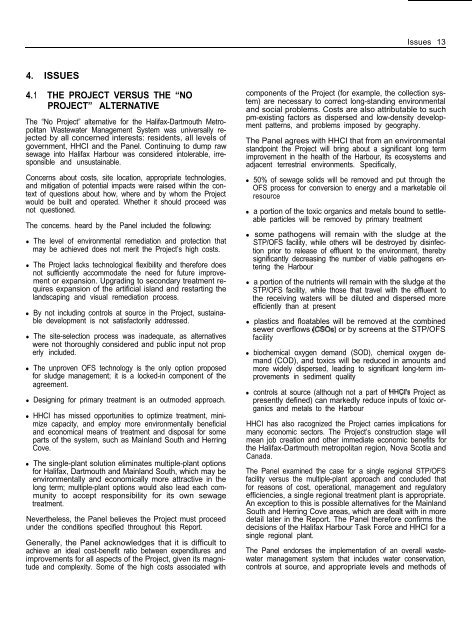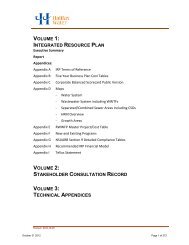Halifax Harbour Cleanup Inc. - Halifax Regional Municipality
Halifax Harbour Cleanup Inc. - Halifax Regional Municipality
Halifax Harbour Cleanup Inc. - Halifax Regional Municipality
You also want an ePaper? Increase the reach of your titles
YUMPU automatically turns print PDFs into web optimized ePapers that Google loves.
Issues 13<br />
4.<br />
ISSUES<br />
4. 1 THE PROJECT VERSUS THE “NO<br />
PROJECT” ALTERNATIVE<br />
The “No Project” alternative for the <strong>Halifax</strong>-Dartmouth Metropolitan<br />
Wastewater Management System was universally rejected<br />
by all concerned interests: residents, all levels of<br />
government, HHCI and the Panel. Continuing to dump raw<br />
sewage into <strong>Halifax</strong> <strong>Harbour</strong> was considered intolerable, irresponsible<br />
and unsustainable.<br />
Concerns about costs, site location, appropriate technologies,<br />
and mitigation of potential impacts were raised within the context<br />
of questions about how, where and by whom the Project<br />
would be built and operated. Whether it should proceed was<br />
not questioned.<br />
The concerns. heard by the Panel included the following:<br />
• The level of environmental remediation and protection that<br />
may be achieved does not merit the Project’s high costs.<br />
• The Project lacks technological flexibility and therefore does<br />
not sufficiently accommodate the need for future improvement<br />
or expansion. Upgrading to secondary treatment requires<br />
expansion of the artificial island and restarting the<br />
landscaping and visual remediation process.<br />
• By not including controls at source in the Project, sustainable<br />
development is not satisfactorily addressed.<br />
• The site-selection process was inadequate, as alternatives<br />
were not thoroughly considered and public input not prop<br />
erly included.<br />
• The unproven OFS technology is the only option proposed<br />
for sludge management; it is a locked-in component of the<br />
agreement.<br />
• Designing for primary treatment is an outmoded approach.<br />
• HHCI has missed opportunities to optimize treatment, minimize<br />
capacity, and employ more environmentally beneficial<br />
and economical means of treatment and disposal for some<br />
parts of the system, such as Mainland South and Herring<br />
Cove.<br />
• The single-plant solution eliminates multiple-plant options<br />
for <strong>Halifax</strong>, Dartmouth and Mainland South, which may be<br />
environmentally and economically more attractive in the<br />
long term; multiple-plant options would also lead each community<br />
to accept responsibility for its own sewage<br />
treatment.<br />
Nevertheless, the Panel believes the Project must proceed<br />
under the conditions specified throughout this Report.<br />
Generally, the Panel acknowledges that it is difficult to<br />
achieve an ideal cost-benefit ratio between expenditures and<br />
improvements for all aspects of the Project, given its magnitude<br />
and complexity. Some of the high costs associated with<br />
components of the Project (for example, the collection system)<br />
are necessary to correct long-standing environmental<br />
and social problems. Costs are also attributable to such<br />
pm-existing factors as dispersed and low-density development<br />
patterns, and problems imposed by geography.<br />
The Panel agrees with HHCI that from an environmental<br />
standpoint the Project will bring about a significant long term<br />
improvement in the health of the <strong>Harbour</strong>, its ecosystems and<br />
adjacent terrestrial environments. Specifically,<br />
• 50% of sewage solids will be removed and put through the<br />
OFS process for conversion to energy and a marketable oil<br />
resource<br />
• a portion of the toxic organics and metals bound to settleable<br />
particles will be removed by primary treatment<br />
• some pathogens will remain with the sludge at the<br />
STP/OFS facility, while others will be destroyed by disinfection<br />
prior to release of effluent to the environment, thereby<br />
significantly decreasing the number of viable pathogens entering<br />
the <strong>Harbour</strong><br />
• a portion of the nutrients will remain with the sludge at the<br />
STP/OFS facility, while those that travel with the effluent to<br />
the receiving waters will be diluted and dispersed more<br />
efficiently than at present<br />
• plastics and floatables will be removed at the combined<br />
sewer overflows (CSOs) or by screens at the STP/OFS<br />
facility<br />
• biochemical oxygen demand (SOD), chemical oxygen demand<br />
(COD), and toxics will be reduced in amounts and<br />
more widely dispersed, leading to significant long-term improvements<br />
in sediment quality<br />
• controls at source (although not a part of HHCl’s Project as<br />
presently defined) can markedly reduce inputs of toxic organics<br />
and metals to the <strong>Harbour</strong><br />
HHCI has also racognized the Project carries implications for<br />
many economic sectors. The Project’s construction stage will<br />
mean job creation and other immediate economic benefits for<br />
the <strong>Halifax</strong>-Dartmouth metropolitan region, Nova Scotia and<br />
Canada.<br />
The Panel examined the case for a single regional STP/OFS<br />
facility versus the multiple-plant approach and concluded that<br />
for reasons of cost, operational, management and regulatory<br />
efficiencies, a single regional treatment plant is appropriate.<br />
An exception to this is possible alternatives for the Mainland<br />
South and Herring Cove areas, which are dealt with in more<br />
detail later in the Report. The Panel therefore confirms the<br />
decisions of the <strong>Halifax</strong> <strong>Harbour</strong> Task Force and HHCI for a<br />
single regional plant.<br />
The Panel endorses the implementation of an overall wastewater<br />
management system that includes water conservation,<br />
controls at source, and appropriate levels and methods of

















